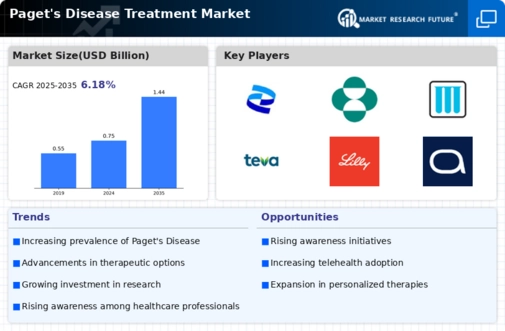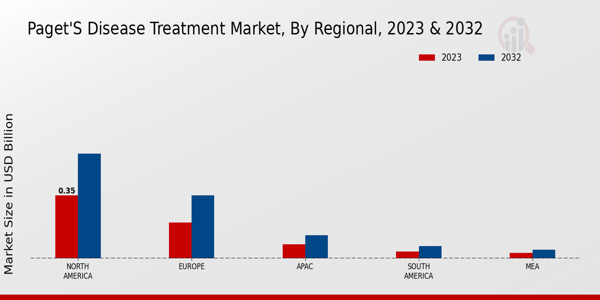Market Growth Projections
The Global Paget's Disease Treatment Market Industry is poised for substantial growth, with projections indicating a market value of 0.75 USD Billion in 2024. This growth trajectory is supported by a compound annual growth rate of 6.09% anticipated from 2025 to 2035, potentially reaching 1.44 USD Billion by 2035. Factors contributing to this growth include advancements in treatment options, increased awareness, and supportive government initiatives. The market's evolution reflects a broader trend towards improved healthcare outcomes for patients suffering from Paget's disease, emphasizing the need for ongoing research and development in this field.
Rising Awareness and Diagnosis
Heightened awareness and improved diagnostic techniques are contributing to the expansion of the Global Paget's Disease Treatment Market Industry. Increased education among healthcare professionals and the public about Paget's disease has led to earlier detection and treatment. Enhanced imaging technologies, such as MRI and CT scans, facilitate accurate diagnosis, allowing for timely intervention. As more patients are diagnosed, the demand for treatment options is likely to surge, further driving market growth. This trend underscores the importance of awareness campaigns and educational initiatives in shaping the future landscape of Paget's disease management.
Supportive Government Initiatives
Government initiatives aimed at improving healthcare access and treatment options are positively influencing the Global Paget's Disease Treatment Market Industry. Policies that promote research funding, patient education, and healthcare infrastructure development are essential for addressing the needs of individuals with Paget's disease. For instance, various countries are implementing programs to enhance access to specialized care and treatment resources. These supportive measures are expected to foster an environment conducive to market growth, as they encourage innovation and the development of new therapies tailored to patient needs.
Advancements in Treatment Modalities
Innovations in treatment modalities are propelling the Global Paget's Disease Treatment Market Industry forward. Emerging therapies, including bisphosphonates and calcitonin, have shown efficacy in managing symptoms and slowing disease progression. The introduction of novel drugs and combination therapies may enhance patient outcomes, thereby increasing market attractiveness. As healthcare systems worldwide adopt these advancements, the market is projected to grow at a compound annual growth rate of 6.09% from 2025 to 2035, potentially reaching a value of 1.44 USD Billion by 2035. This growth reflects the ongoing commitment to improving patient care and treatment efficacy.
Increasing Prevalence of Paget's Disease
The Global Paget's Disease Treatment Market Industry is experiencing growth due to the rising prevalence of Paget's disease. As populations age, the incidence of this bone disorder appears to increase, particularly among individuals over 50 years old. Current estimates suggest that approximately 1% of adults in this age group are affected, leading to a growing demand for effective treatment options. This trend is likely to drive the market value to reach 0.75 USD Billion in 2024, as healthcare providers seek to address the needs of this demographic through targeted therapies and management strategies.
Aging Population and Healthcare Expenditure
The aging population is a significant driver of the Global Paget's Disease Treatment Market Industry. As the demographic landscape shifts, healthcare expenditure is likely to increase, particularly in the management of chronic conditions like Paget's disease. Older adults often require more comprehensive healthcare services, leading to higher spending on treatments and interventions. This trend is expected to result in a growing market, with projections indicating a rise to 1.44 USD Billion by 2035. The correlation between an aging population and increased healthcare investment underscores the importance of addressing the needs of this demographic in the context of Paget's disease.
















